人教版小学英语语法汇总
(完整版)人教版小学英语语法知识点汇总
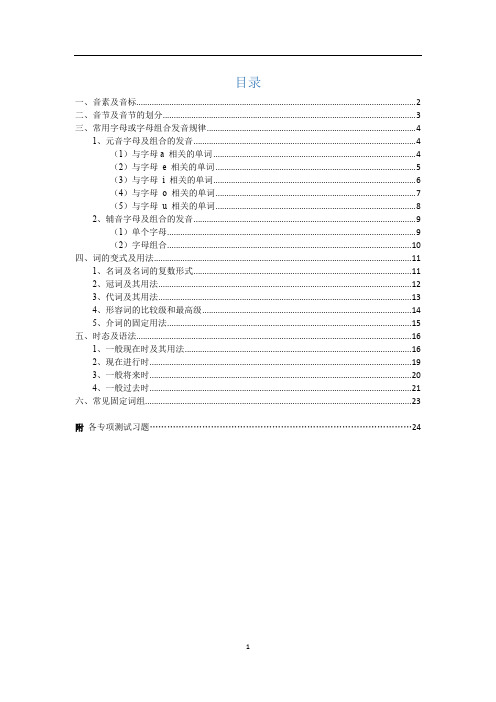
目录一、音素及音标 (2)二、音节及音节的划分 (3)三、常用字母或字母组合发音规律 (4)1、元音字母及组合的发音 (4)(1)与字母a 相关的单词 (4)(2)与字母 e 相关的单词 (5)(3)与字母i 相关的单词 (6)(4)与字母o 相关的单词 (7)(5)与字母u 相关的单词 (8)2、辅音字母及组合的发音 (9)(1)单个字母 (9)(2)字母组合 (10)四、词的变式及用法 (11)1、名词及名词的复数形式 (11)2、冠词及其用法 (12)3、代词及其用法 (13)4、形容词的比较级和最高级 (14)5、介词的固定用法 (15)五、时态及语法 (16)1、一般现在时及其用法 (16)2、现在进行时 (19)3、一般将来时 (20)4、一般过去时 (21)六、常见固定词组 (23)附各专项测试习题 (24)一、音素及音标音素:英语把组成一个读音的最小单位叫音素。
因素分为元音和辅音(相当于语文中的韵母和声母)1、元音(韵母)1.1发音方式:靠声带发音,有声调,气流通过喉头、口腔不受阻碍。
1.2举例:元音单元音长元音[a:][ә:][i:][ɔ:][u:]短元音[Λ][ә][i][ɔ][u][æ][e]双元音[ai][ei][ɔi][iә ][eә ][uә ][au][әu]1.3元音的结构元音的常见构成有:组合方式举例1单个元音字母D o g2元音字母+元音字母S ee、s ea、m ea t、b oo k3元音字母+辅音字母T al l、pl ay1.4元音字母共有5个,分别是:a e i o u2、辅音(声母)2.1发音方式:主要是用气流与牙齿舌头等其它器官摩擦发音,气流通过喉头、口腔要受到某个部位的阻碍。
2.2举例:辅音10对清辅音[p] [t] [k] [f] [s] [∫][t∫][tr] [θ][ts]浊辅音[b] [d] [g] [v] [z] [ʒ][dʒ][dr] [ð] [dz] 3个鼻音[m] [n] [η]3个似拼音[h] [r] [l]2个半元音[w] [j]2.3辅音的结构组合方式举例1单个辅音字母D og、b ook2辅音字母+辅音字tr ee、dr aw、tea ch、sh ip 2.4辅音字母26个字母中,除去5个元音字母(a、e、i、o、u),其他字母都是辅音字母。
小学人教版英语语法大全
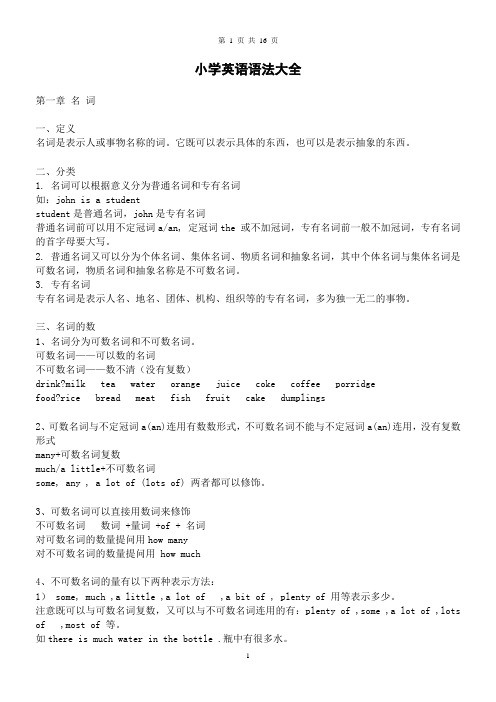
小学英语语法大全第一章名词一、定义名词是表示人或事物名称的词。
它既可以表示具体的东西,也可以是表示抽象的东西。
二、分类1. 名词可以根据意义分为普通名词和专有名词如:john is a studentstudent是普通名词,john是专有名词普通名词前可以用不定冠词a/an, 定冠词the 或不加冠词,专有名词前一般不加冠词,专有名词的首字母要大写。
2. 普通名词又可以分为个体名词、集体名词、物质名词和抽象名词,其中个体名词与集体名词是可数名词,物质名词和抽象名称是不可数名词。
3. 专有名词专有名词是表示人名、地名、团体、机构、组织等的专有名词,多为独一无二的事物。
三、名词的数1、名词分为可数名词和不可数名词。
可数名词——可以数的名词不可数名词——数不清(没有复数)drink?milk tea water orange juice coke coffee porridgefood?rice bread meat fish fruit cake dumplings2、可数名词与不定冠词a(an)连用有数数形式,不可数名词不能与不定冠词a(an)连用,没有复数形式many+可数名词复数much/a little+不可数名词some, any , a lot of (lots of) 两者都可以修饰。
3、可数名词可以直接用数词来修饰不可数名词数词 +量词 +of + 名词对可数名词的数量提问用how many对不可数名词的数量提问用 how much4、不可数名词的量有以下两种表示方法:1) some, much ,a little ,a lot of ,a bit of , plenty of 用等表示多少。
注意既可以与可数名词复数,又可以与不可数名词连用的有:plenty of ,some ,a lot of ,lots of ,most of 等。
如there is much water in the bottle .瓶中有很多水。
人教版小学英语语法汇总

9. monkey _m_o_n_ke_y_s____ 10. wife _w_i_ve_s______
11. rose _r_o_s_e_s _______ 12. path _p_a_th_s______
13. judge _ju_d_g_e_s______ 14. map _m_a_p_s_______
soul. 9. She
studies
at
__/__No.
3
Middle
School.
She
goes
to
__/__
school
by
___/_ bus every day.
10. My elder sister is __a___student of __/___ English. She studies at
Practise
1. There is __a___notebook on my desk. I use _t_h_e__ notebook to keep a
diary.
2. There is __a____bottle on the table. _T_h__e_ water in it is sweet. 3. Wang's mother is __a_n___English teacher. She teaches in t_h__e__
3. 用在单数的表语名词前,以表示职业、行业、宗教、等级等。 George wants to be an engineer.
4. 在以what引导的感叹句中,单数的可数名词前。 What a pretty girl!
5. 一些常用短语中。 have a good time, half an hour, have a headache….
人教版小学英语语法大全 小学六年级必备
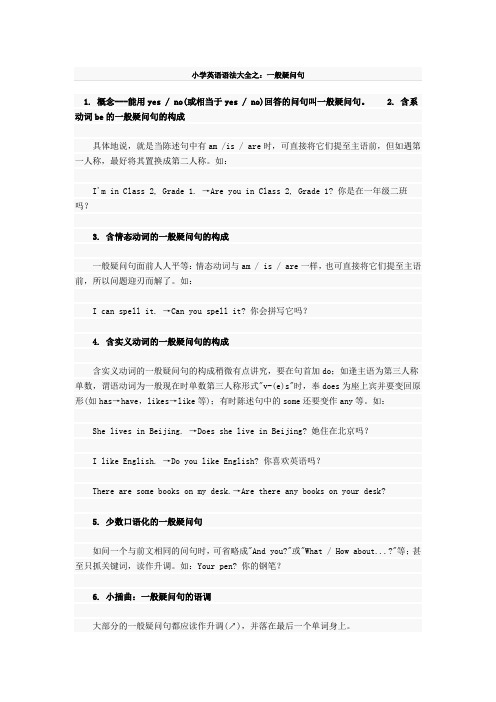
1. 概念---能用yes / no(或相当于yes / no)回答的问句叫一般疑问句。
2. 含系动词be的一般疑问句的构成具体地说,就是当陈述句中有am /is / are时,可直接将它们提至主语前,但如遇第一人称,最好将其置换成第二人称。
如:I'm in Class 2, Grade 1. →Are you in Class 2, Grade 1? 你是在一年级二班吗?3. 含情态动词的一般疑问句的构成一般疑问句面前人人平等:情态动词与am / is / are一样,也可直接将它们提至主语前,所以问题迎刃而解了。
如:I can spell it. →Can you spell it? 你会拼写它吗?4. 含实义动词的一般疑问句的构成含实义动词的一般疑问句的构成稍微有点讲究,要在句首加do;如逢主语为第三人称单数,谓语动词为一般现在时单数第三人称形式"v-(e)s"时,奉does为座上宾并要变回原形(如has→have,likes→like等);有时陈述句中的some还要变作any等。
如:She lives in Beijing. →Does she live in Beijing? 她住在北京吗?I like English. →Do you like English? 你喜欢英语吗?There are some books on my desk.→Are there any books on your desk?5. 少数口语化的一般疑问句如问一个与前文相同的问句时,可省略成"And you?"或"What / How about...?"等;甚至只抓关键词,读作升调。
如:Your pen? 你的钢笔?6. 小插曲:一般疑问句的语调大部分的一般疑问句都应读作升调(↗),并落在最后一个单词身上。
如:Is it a Chinese car↗?7. 一般疑问句的应答用yes / no(或相当于yes / no的词)回答,并怎么问怎么答(句首为情态动词am / i s / are还是do /does),简略回答时要注意缩写(否定的n't)和采用相应的人称代词以避免重复:即"Yes,主语(代词)+情态动词或am / is / are或do / does."表示肯定;"No,主语(代词)+情态动词或am / is / are或者do / does not(n't)."表示否定。
人教版小学四年级英语语法总结

一、名词复数规则1. 一般情况,直接加-s,如:book-books, bag-bags, cat-cats2. 以s. x. sh. ch结尾,加-es,如:bus-buses, box-boxes, watch-watches(手表)3. 以“辅音字母+y”结尾,变y为i, 再加-es,如:family-families, strawberry-strawberries 但boy-boys4. 以“f或fe”结尾,变f或fe为v, 再加-es,如:knife-knives leaf-leaves5. 以o结尾有生命的加es 无生命的加s,如:potato-potatoes tomatoes photo-photos piano-pianos不规则名词的复数:man-men, woman-women, policeman-policemen, policewoman-policewomen, child-children, foot-feet, tooth-teeth, fish-fish, people-people, Chinese-Chinese, goose-geese不可数名词没有复数形式: paper, juice, water, milk, rice, tea 在具体句子中我们应该把不可数名词当成单数看待二、一般现在时一般现在时的功能1.表示事物或人物的特征、状态。
如:The sky is blue.天空是蓝色的。
2.表示经常性或习惯性的动作。
如:I get up at six every day.我每天六点起床。
3.表示客观现实。
如:The earth goes around the sun.地球绕着太阳转。
一般现在时的标志词:often, usually, sometimes, every等一般现在时的构成主语+动词原形。
如: We study English. 我们学习英语。
(完整)人教版小学英语语法知识点汇总,推荐文档

目录一、音素及音标 (2)二、音节及音节的划分 (3)三、常用字母或字母组合发音规律 (4)1、元音字母及组合的发音 (4)(1)与字母a 相关的单词 (4)(2)与字母 e 相关的单词 (5)(3)与字母i 相关的单词 (6)(4)与字母o 相关的单词 (7)(5)与字母u 相关的单词 (8)2、辅音字母及组合的发音 (9)(1)单个字母 (9)(2)字母组合 (10)四、词的变式及用法 (11)1、名词及名词的复数形式 (11)2、冠词及其用法 (12)3、代词及其用法 (13)4、形容词的比较级和最高级 (14)5、介词的固定用法 (15)五、时态及语法 (16)1、一般现在时及其用法 (16)2、现在进行时 (19)3、一般将来时 (20)4、一般过去时 (21)六、常见固定词组 (23)附各专项测试习题 (24)一、音素及音标音素:英语把组成一个读音的最小单位叫音素。
因素分为元音和辅音(相当于语文中的韵母和声母)1、元音(韵母)1.1发音方式:靠声带发音,有声调,气流通过喉头、口腔不受阻碍。
元音单元音长元音[a:][ә:][i:][ɔ:][u:]短元音[Λ][ә][i][ɔ][u][æ][e]双元音[ai][ei][ɔi][iә ][eә ][uә ][au][әu]1.3元音的结构元音的常见构成有:组合方式举例1单个元音字母D o g2元音字母+元音字母S ee、s ea、m ea t、b oo k3元音字母+辅音字母T al l、pl aya e i o u2、辅音(声母)2.1发音方式:主要是用气流与牙齿舌头等其它器官摩擦发音,气流通过喉头、口腔要受到某个部位的阻碍。
辅音10对清辅音[p] [t] [k] [f] [s] [∫][t∫][tr] [θ][ts]浊辅音[b] [d] [g] [v] [z] [ʒ][dʒ][dr] [ð] [dz] 3个鼻音[m] [n] [η]3个似拼音[h] [r] [l]2个半元音[w] [j]组合方式举例1单个辅音字母D og、b ook2辅音字母+辅音字tr ee、dr aw、tea ch、sh ip26个字母中,除去5个元音字母(a、e、i、o、u),其他字母都是辅音字母。
人教版小学英语语法大全

一.名词复数规矩1.一般情形下,直接加-s,如:book-books, bag-bags, cat-cats, bed-beds2.以s. x. sh. ch结尾,加-es,如:bus-buses, box-boxes, brush-brushes, watch-watches3.以“子音字母y”结尾,变y为i, 再加-es,如:family-families, strawberry-strawberries4.以“f或fe”结尾,变f或fe为v, 再加-es,如:knife-knives Leaf——leaves5.不规矩名词复数:man-men, woman-women, policeman-policemen, policewoman-policewomen,child-children foot-feet, tooth-teeth fish-fish, people-people, Chinese-Chinese, Japanese-Japanese二.一般如今时一般如今时根本用法介绍【No. 1】一般如今时的功效1.暗示事物或人物的特点.状况.如:The sky is blue.天空是蓝色的.2.暗示经常性或习惯性的动作.如:I get up at six every day.我天天六点起床.3.暗示客不雅实际.如:The earth goes around the sun.地球绕着太阳转.一般如今时的组成1. be动词:主语be(am,is,are) 其它.如:I am a boy.我是一个男孩.2.行动动词:主语行动动词( 其它).如:We study English.我们进修英语.当主语为第三人称单数(he, she,it)时,要在动词后加"-s"或"-es".如:Mary likes Chinese.玛丽爱好汉语.【No. 2】一般如今时的变更1. be动词的变更.否认句:主语 be not 其它. 如:He is not a worker.他不是工人.一般疑问句:Be 主语其它.如:-Are you a student?-Yes. I am. / No, I'm not.不凡疑问句:疑问词一般疑问句.如:Where is my bike?2.行动动词的变更.否认句:主语 don't( doesn't ) 动词本相( 其它).如:I don't like bread.当主语为第三人称单数时,要用doesn't组成否认句.如:He doesn't often play.一般疑问句:Do( Does ) 主语动词本相其它.如:- Do you often play football?- Yes, I do. / No, I don't.当主语为第三人称单数时,要用does组成一般疑问句.如:- Does she go to work by bike?- Yes, she does. / No, she doesn't.动词 s的变更规矩1.一般情形下,直接加-s,如:cook-cooks, milk-milks2.以s. x. sh. ch. o结尾,加-es,如:guess-guesses, wash-washes, watch-watches, go-goes3.以“子音字母y”结尾,变y为i, 再加-es,如:study-studies三.如今进行时1.如今进行时暗示如今正在进行或产生的动作,也可暗示当前一段时光内的运动或现阶段正在进行的动作.2.如今进行时的确定句根本构造为be 动词ing.3.如今进行时的否认句在be后加not.4.如今进行时的一般疑问句把be动词调到句首.5.如今进行时的不凡疑问的根本构造为:疑问词不达意 be 主语动词ing?但疑问词当主语时其构造为:疑问词不达意 be 动词ing?动词加ing的变更规矩1.一般情形下,直接加ing,如:cook-cooking2.以不发音的e结尾,去e加ing,如:make-making, taste-tasting3.假如末尾是一个元音字母和一个子音字母,双写末尾的子音字母,再加ing,如:run-running, stop-stopping四.未来时理论及演习一.概念:暗示将要产生的动作或消失的状况及打算.筹划或准备做某事.句中一般有以下时光状语:tomorrow, next day(week, month, year…),soon, the day after tomorrow(后天)等.二.根本构造:①be going to do; ②will do.三.否认句:在be动词(am, is, are)l后加not或情态动词will后加not成won’t.例如:I’m going to have a picnic this afternoon.→I’m not going to have a picnic this afternoon.四.同义句:be going to = willI am going to go swimming tomorrow(明天). = I will go swimming tomorrow.五.一般曩昔时1.一般曩昔时暗示曩昔某个时光产生的动作或消失的状况,常和暗示曩昔的时光状语连用.一般曩昔时也暗示曩昔经常或重复产生的动作.2.Be动词在一般曩昔时中的变更:⑴am 和is在一般曩昔时中变成was.(was not=wasn’t)⑵are在一般曩昔时中变成were.(were not=weren’t)3.句中没有be动词的一般曩昔时的句子否认句:didn’t 动词本相,如:Jim didn’t go home yesterday.动词曩昔式变更规矩:1.一般在动词末尾加-ed,如:work__-worked , cook-cooked2.结尾是e加d,如:live____lived3.末尾只有一个元音字母和一个子音字母的重读闭音节,应双写末尾的子音字母,再加-ed,如:stop-stopped4.以“子音字母y”结尾的,变y为i,再加-ed,如:study-studied5.不规矩动词曩昔式:am,is-was, are-were, do-did, see-saw, say-said, give-gave, get-got, go-went, come-came, have-had, eat-ate, take-took, run-ran, sing-sang, put-put, make-made, read-read, write-wrote, draw-drew, drink-drank, swim-swam, sit-sat六.人称代词和物主代词主格宾格形容词性名词性I me my mineyou you your yourshe him his hisshe her her hersit it its itswe us our ours具体用法1.Hello 的用法:Hello 的意思为“您好” ,一般可作为熟人,亲友石友之间的打召唤用语,语气比较随意,例如:Hello,Li Hua!你好,李华. Hello,Tom!你好,汤姆!Hello 也可以用以引起或人留意,经常应用在打德律风时或者在路上碰见熟人时,相当于中文中的“喂”,有时也可用Hi 来代替hello ,但前者显得更随意.2.What's your name?的用法:当两人初次会晤互相讯问姓名时,可用What's your name?来提问,答复时,可用My name is ….来答复,接着反问对方时,可用And what's your name?来提问.例如:Hi!What's your name? 你好,你叫什么名字?Hi!My name is Lucy.And what's your name? 你好,我叫露西.你叫什么名字?My name is Wang Ying. 我叫王英.句中的What's是What is的缩写情势.3.Good morning,class (teacher).的用法:Good morning,class.同窗们好. Good morning,teacher.师长教师好.这是上午上课时,师长教师和全班同窗互相问候时用语.Good morning 是上午问候时的用语,多用于熟人,同伙或家人之间,是比较正式的问候用语.句中问候语放在前面,称呼语则要放在后面,并用逗号离隔.例如: Good morning.Mr.White.怀特师长教师,你好.4.英语字母:英语中有26个字母,每一字母有大写情势和小写情势两种.大小写情势如下:A aB bC cD dE eF fG gH hI IJ j K k L l M m N n O o P p Q q R rS s T t U u V v W w X x Y y Z z1.Are you…?的用法.这是一疑问句型,意思是“你是……吗?”用来讯问姓名,职业,身份等,例如:Are you a worker?你是一名工人吗?Are you a student?你是学生吗?答复时用Yes,I am.(是的,我是.)或者No,I'm not.(不,我不是)来答复,留意Yes和No 后面都有逗号,不克不及省略.2.Nice to meet you.的用法:这是两位初次会晤了解后的用语,意思是“见到你很愉快.”会晤了解可由毛遂自荐,第三者介绍或者讯问了解.例如:Hello!I'm Xiao Hua. 你好,我是小华Hello!I'm Xiao Li. 你好,我是小李.Nice to meet you,Xiao Li. 小李,见到你我很愉快.Nice to meet you,too,Xiao Hua. 小华,见到你我也很愉快.3.Where is …?的用法:这一句型暗示“某物或或人在什么地方”.它同中文的句型构造不一样,where在前,而某物或或人在后,例如:Where is my book? 我的书在哪儿?It's there. 在这儿.Where is Tom? Tom在哪儿?He is here. 他在这儿.句中的where is可以缩写成“where's”.4.am,is和are 的用法:这三个词都是“是”的寄义,但用法比中文中的“是”要庞杂,英语中的am,is 和are都是be 的变更情势,依据不合的主语选用不合的动词,主语I 用am,暗示复数的主语和单数“you”则要用are,其它则用is.I am a teacher.我是教师.You are a worker.你是一个工人.You are students.你们是学生.She is Miss Gao.她是高蜜斯.This book is mine.这本书是我的.【与熟人打召唤】:英丽人一天中会晤都要打召唤,依据一天中不合的时光选用不合的说法,早上和上午时说Good morning,下昼时说,Good afternoon,晚上会晤时则要说Good evening.对方也用雷同的问候语来答复.例如: Good morning,Mr.Green. Good morning,Miss Li.【Sorry 的用法】:Sorry 暗示“对不起”或“抱愧”,用于对本身的错误,掉误,不克不及做某事或者不克不及供给对方的要求时经常应用sorry 或者I'm sorry来暗示.例如:Can you spell your name? 你能拼一下你的名字吗?I'm sorry.I can't. 对不起,我不克不及.What's the time,please? 请问几点钟了?Sorry,I don't know. 对不起,我不知道.【Excuse me 的用法】:这是用于向或人讯问一件事或提出要求而打搅或人时的用语.意思是“对不起”,“请问”.例如:Excuse me!Where is my bag?对不起,我的包在哪儿呢?Excuse me!Are you Teacher Wang?对不起,请问你是王师长教师吗?【What's …的用法】:这个句型用于讯问或人叫什么或者某个器械是什么,例如:What's this?It's a book.这是什么?这是一本书.What's your name? 你叫什么名字?My name is Lucy. 我叫Lucy.。
人教版PEP小学英语语法要点及习题
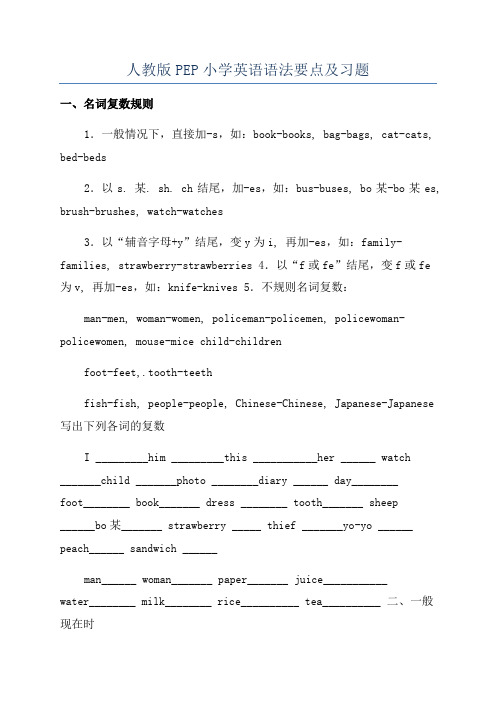
人教版PEP小学英语语法要点及习题一、名词复数规则1.一般情况下,直接加-s,如:book-books, bag-bags, cat-cats, bed-beds2.以s. 某. sh. ch结尾,加-es,如:bus-buses, bo某-bo某es, brush-brushes, watch-watches3.以“辅音字母+y”结尾,变y为i, 再加-es,如:family-families, strawberry-strawberries 4.以“f或fe”结尾,变f或fe为v, 再加-es,如:knife-knives 5.不规则名词复数:man-men, woman-women, policeman-policemen, policewoman-policewomen, mouse-mice child-childrenfoot-feet,.tooth-teethfish-fish, people-people, Chinese-Chinese, Japanese-Japanese 写出下列各词的复数I _________him _________this ___________her ______ watch_______child _______photo ________diary ______ day________foot________ book_______ dress ________ tooth_______ sheep______bo某_______ strawberry _____ thief _______yo-yo ______ peach______ sandwich ______man______ woman_______ paper_______ juice___________water________ milk________ rice__________ tea__________ 二、一般现在时一般现在时基本用法介绍【No.1】一般现在时的功能1.表示事物或人物的特征、状态。
(完整版)人教版小学英语所有语法
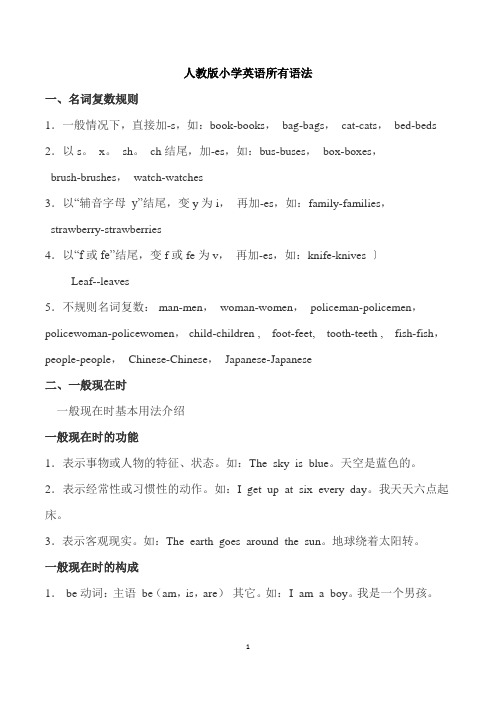
人教版小学英语所有语法一、名词复数规则1.一般情况下,直接加-s,如:book-books,bag-bags,cat-cats,bed-beds 2.以s。
x。
sh。
ch结尾,加-es,如:bus-buses,box-boxes,brush-brushes,watch-watches3.以“辅音字母y”结尾,变y为i,再加-es,如:family-families,strawberry-strawberries4.以“f或fe”结尾,变f或fe为v,再加-es,如:knife-knives 〕Leaf--leaves5.不规则名词复数: man-men,woman-women,policeman-policemen,policewoman-policewomen, child-children , foot-feet, tooth-teeth ,fish-fish,people-people,Chinese-Chinese,Japanese-Japanese二、一般现在时一般现在时基本用法介绍一般现在时的功能1.表示事物或人物的特征、状态。
如:The sky is blue。
天空是蓝色的。
2.表示经常性或习惯性的动作。
如:I get up at six every day。
我天天六点起床。
3.表示客观现实。
如:The earth goes around the sun。
地球绕着太阳转。
一般现在时的构成1.be动词:主语be(am,is,are)其它。
如: I am a boy。
我是一个男孩。
2.行为动词:主语行为动词(其它)。
如:We study English。
我们学习英语。
当主语为第三人称单数(he,she,it)时,要在动词后加“-s”或“-es”。
如:M ary likes Chinese。
玛丽喜欢汉语。
一般现在时的变化1.be动词的变化。
否定句:主语be not 其它。
如:He is not a worker。
最新人教版小学英语语法知识点整理教材
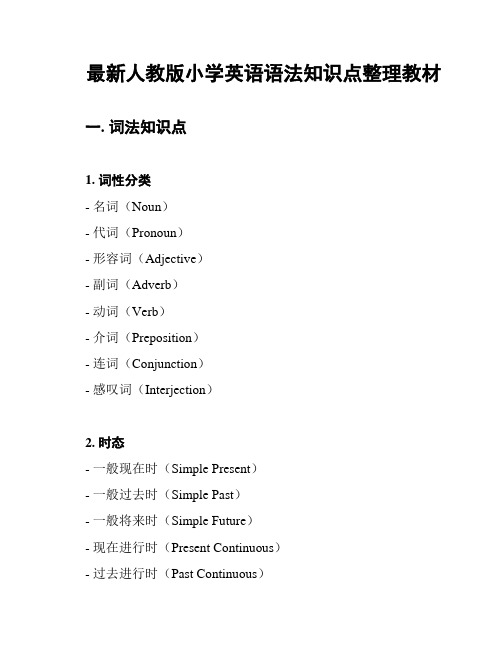
最新人教版小学英语语法知识点整理教材一. 词法知识点1. 词性分类- 名词(Noun)- 代词(Pronoun)- 形容词(Adjective)- 副词(Adverb)- 动词(Verb)- 介词(Preposition)- 连词(Conjunction)- 感叹词(Interjection)2. 时态- 一般现在时(Simple Present)- 一般过去时(Simple Past)- 一般将来时(Simple Future)- 现在进行时(Present Continuous)- 过去进行时(Past Continuous)- 将来进行时(Future Continuous)- 现在完成时(Present Perfect)- 过去完成时(Past Perfect)- 将来完成时(Future Perfect)3. 数量- 单数(Singular)- 复数(Plural)二. 句法知识点1. 句型分类- 陈述句(Declarative Sentence)- 疑问句(Interrogative Sentence)- 肯定回答(Affirmative Answer)- 否定回答(Negative Answer)- 祈使句(Imperative Sentence)- 感叹句(Exclamatory Sentence)2. 语序- 主谓语序(Subject-Verb Word Order)- 主谓宾语序(Subject-Verb-Object Word Order)3. 从句- 定语从句(Adjective Clause)- 状语从句(Adverbial Clause)- 名词性从句(Noun Clause)三. 常用语法运用1. 祈使句- 表示命令、请求、建议等,用动词原形开头,句子结尾可以用感叹号或句号。
- 例如:Stop talking!(停止讲话!)2. 一般现在时- 表示经常性的动作、惯或客观事实。
人教版小学英语语法整理可直接打印版

英语语法点整理1。
人称代词主格:I we you she he it they宾格:me us you her him it them形容词性物主代词:my our your her his its their名词性物主代词: mine ours yours hers his its theirs2.形容词和副词的比较级(1) 一般在形容词或副词后+erolder taller longer stronger, etc(2) 多音节词前+moremore interesting, etc。
(3)双写最后一个字母,再+erbigger fatter,etc.(4) 把y变i,再+erheavier, earlier(5) 不规则变化:well-better,much/many-more, etc.3。
可数词的复数形式Most nouns + s a book –booksNouns ending in a consonant +y - y+ ies a story-storiesNouns ending in s, sh, ch or x + es a glass—glasses a watch-watches Nouns ending in o +s or +es a piano—pianos a mango-mangoesNouns ending in f or fe - f or fe +ves a knife –knives a shelf-shelves 4。
不可数名词(单复数形式不变)bread, rice, water ,juice etc.5。
缩略形式I’m = I am you’re = you are she’s = she is he’s = he isit’s = it is who’s =who is can’t =can not isn’t=is not etc6。
a/ana book,a peachan egg an hour7. Preposition:on,in ,in front of, between,next to, near, beside, at, behind。
人教版小学英语语法要点整理

人教版小学英语语法要点整理一、名词- 名词是用来表示人、事物、地方或抽象概念的词语。
- 有可数名词和不可数名词之分。
- 可数名词有单数和复数形式,复数形式通常在词尾加-s或-es。
- 不可数名词没有形式上的区别,表示不能分为个体的事物或抽象概念。
二、代词- 代词是用来代替名词的词语,用以避免重复使用名词。
- 人称代词包括主格和宾格,用于代替人。
- 物主代词用来表示所属关系。
- 指示代词用来指示人或事物。
- 不定代词用来泛指某人或某物。
三、形容词- 形容词用来描述名词的特征或性质。
- 形容词有原级、比较级和最高级之分。
- 比较级用于比较两个人或事物的特征。
- 最高级用于比较三个或三个以上的人或事物的特征。
四、动词- 动词是描述或表示动作、状态或存在的词语。
- 动词有时态和语态之分。
- 时态表示动作发生的时间,包括过去、现在和将来。
- 语态表示动作的主动还是被动。
五、副词- 副词用来修饰动词、形容词或其他副词。
- 副词可以表示时间、地点、程度等概念。
六、连词- 连词是用于连接词语、短语或句子的词语。
- 常用的连词包括并列连词、递进连词、转折连词、因果连词等。
七、介词- 介词用于表示时间、地点、方式、原因等关系。
- 介词通常与名词、代词或动词的-ing形式连用。
八、冠词- 冠词用于限定名词的范围。
- 不定冠词a/an用于泛指单数名词。
- 定冠词the用于特指某个人或事物。
九、句子- 句子是由词组成的表达完整意思的语言单位。
- 句子包含主语和谓语,可以有附加成分如宾语、宾语补足语等。
以上是人教版小学英语语法的要点整理,希望对您有所帮助。
人教版小学四年级英语语法总结(供参考)
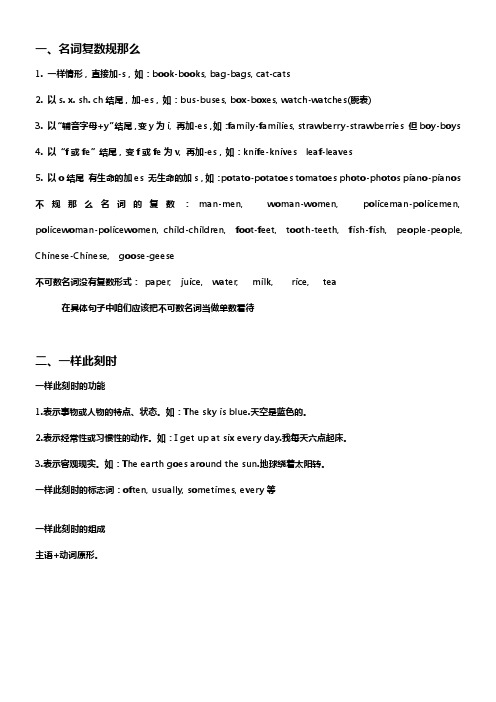
一、名词复数规那么1. 一样情形,直接加-s,如:book-books, bag-bags, cat-cats2. 以s. x. sh. ch结尾,加-es,如:bus-buses, box-boxes, watch-watches(腕表)3. 以“辅音字母+y”结尾,变y为i, 再加-es,如:family-families, strawberry-strawberries 但boy-boys4. 以“f或fe”结尾,变f或fe为v, 再加-es,如:knife-knives leaf-leaves5. 以o结尾有生命的加es 无生命的加s,如:potato-potatoes tomatoes photo-photos piano-pianos 不规那么名词的复数:man-men, woman-women, policeman-policemen, policewoman-policewomen, child-children, foot-feet, tooth-teeth, fish-fish, people-people, Chinese-Chinese, goose-geese不可数名词没有复数形式:paper, juice, water, milk, rice, tea在具体句子中咱们应该把不可数名词当做单数看待二、一样此刻时一样此刻时的功能1.表示事物或人物的特点、状态。
如:The sky is blue.天空是蓝色的。
2.表示经常性或习惯性的动作。
如:I get up at six every day.我每天六点起床。
3.表示客观现实。
如:The earth goes around the sun.地球绕着太阳转。
一样此刻时的标志词:often, usually, sometimes, every等一样此刻时的组成主语+动词原形。
如:We study English. 咱们学习英语。
人教版小学英语语法汇总

小学英语语法汇总1.元音音标开头的单词用an,辅音音标开头的单词用a.2.肯定句用some,疑问句和否定句用any。
3.have ,has表示某人有,第三人称单数用has ,其他用have。
4.there be表示某地有…… 单数用there is ,复数用there are.5.序数词前要加“the”,序数词一般用于:①日期②第几…③名次6.否定句是在肯定句的基础上加上了否定词“not”。
有be动词(am\is\are)的句子则“not”加在be后面,可缩写成“isn’t,aren’t”,但am not 一般都分开写。
没有be动词的要先在动词前面加助动词(do、does或did),再加上“not”,缩写为“don’t ,doesn’t ,didn’t ,然后把后面的动词变回原形。
7.一般疑问句:是指询问事实的句子,用“yes”,或“no”来回答。
一般疑问句是在肯定句的基础上进行变化:①把be动词调到首位,其他照写,末尾标点符号变成问号。
②没有be动词的句子在句首加上助动词(do,does,did,)再把后面的动词变回原形。
8.be动词I用am ,you用are ,is跟着他她它,复数后面都用are9.助动词(do/does/did)+动词原形…?Do+非第三人称单数Does+第三人称单数Did+所有主语10.情态动词can,must,could,would,may,shall,后面跟动词原形11.祈使句中动词用原形Let’s\Let me +动词原形…12. 时间介词①in+年、月、季节\the morning\the afternoon②on+日期、星期、假期③at+点钟\noon\night13.音节每个元音音标可以构成一个音节。
开音节:1)以元音字母结尾的音节。
例:go,by。
2)以不发音的e结尾的音节。
例:make,like。
在重读的开音节中元音字母按字母名称读音。
闭音节:以辅音字母(r 除外)结尾的音节,称为闭音节。
人教版小学英语语法知识点汇总简要

小学英语人教版重点语法汇总
一、发音
1、元音字母及组合的发音(a e i o u)
2、辅音字母及组合的发音
二、词的变式及用法
1、Be动词(am is are)
2、助动词(do does did)
3、动词(情态动词、动词三单形式、动名词、过去式)
4、名词(名词所有格、名词复数形式)
5、冠词(定冠词the、不定冠词a/an、零冠词)
6、代词(人称代词及物主代词及反身代词、指示代词)
7、形容词(比较级和最高级)
8、副词(频度副词、比较级和最高级)
9、介词(时间介词、方位介词、方式介词)
10、基数词和序数词
三、时态及语法
1、一般现在时
2、现在进行时
3、一般将来时
4、一般过去时
四、句型
1、肯定句
2、否定句(加not)
3、一般疑问句(Be动词引导、助动词引导、情态动词引导)
4、特殊疑问句(常见特殊疑问词)
5、There be 句型
6、How和What 引导的感叹句
7、祈使句(Do型、Be型、Let型、No型)
五、课文短语搭配、基础句型
1。
(完整版)人教版小学英语语法知识点汇总,推荐文档

目录一、音素及音标 (2)二、音节及音节的划分 (3)三、常用字母或字母组合发音规律 (4)1、元音字母及组合的发音 (4)(1)与字母a 相关的单词 (4)(2)与字母 e 相关的单词 (5)(3)与字母i 相关的单词 (6)(4)与字母o 相关的单词 (7)(5)与字母u 相关的单词 (8)2、辅音字母及组合的发音 (9)(1)单个字母 (9)(2)字母组合 (10)四、词的变式及用法 (11)1、名词及名词的复数形式 (11)2、冠词及其用法 (12)3、代词及其用法 (13)4、形容词的比较级和最高级 (14)5、介词的固定用法 (15)五、时态及语法 (16)1、一般现在时及其用法 (16)2、现在进行时 (19)3、一般将来时 (20)4、一般过去时 (21)六、常见固定词组 (23)附各专项测试习题 (24)一、音素及音标音素:英语把组成一个读音的最小单位叫音素。
因素分为元音和辅音(相当于语文中的韵母和声母)1、元音(韵母)1.1发音方式:靠声带发音,有声调,气流通过喉头、口腔不受阻碍。
1.2举例:元音单元音长元音[a:][ә:][i:][ɔ:][u:]短元音[Λ][ә][i][ɔ][u][æ][e]双元音[ai][ei][ɔi][iә ][eә ][uә ][au][әu]1.3元音的结构元音的常见构成有:组合方式举例1单个元音字母D o g2元音字母+元音字母S ee、s ea、m ea t、b oo k3元音字母+辅音字母T al l、pl ay1.4元音字母共有5个,分别是:a e i o u2、辅音(声母)2.1发音方式:主要是用气流与牙齿舌头等其它器官摩擦发音,气流通过喉头、口腔要受到某个部位的阻碍。
2.2举例:辅音10对清辅音[p] [t] [k] [f] [s] [∫][t∫][tr] [θ][ts]浊辅音[b] [d] [g] [v] [z] [ʒ][dʒ][dr] [ð] [dz] 3个鼻音[m] [n] [η]3个似拼音[h] [r] [l]2个半元音[w] [j]2.3辅音的结构组合方式举例1单个辅音字母D og、b ook2辅音字母+辅音字tr ee、dr aw、tea ch、sh ip 2.4辅音字母26个字母中,除去5个元音字母(a、e、i、o、u),其他字母都是辅音字母。
人教版五年级英语语法

人教版五年级英语语法
以下是五年级英语语法的部分总结:
一、一般现在时
一般现在时表示经常或习惯性的动作,也可表示现在的状态或主语具备的性格和能力。
基本结构:主语+谓语+其他(表状态)
二、现在进行时
现在进行时表示此时此刻正在进行的动作或目前阶段正在进行的动作。
基本结构:主语+be动词+动词ing+其他
三、一般过去时
一般过去时表示过去某个时间里发生的动作或存在的状态。
常和表示过去的时间状语连用。
基本结构:主语+谓语+其他(表过去状态)
四、一般将来时
一般将来时表示将来某个时间里将要发生的动作或存在的状态,也表示将来经常或反复发生的动作。
常和表示将来的时间状语连用。
基本结构:主语+will/be going to+动词原形+其他
以上是五年级英语语法中的部分内容,更多内容建议查阅五年级英语课本或咨询英语老师。
- 1、下载文档前请自行甄别文档内容的完整性,平台不提供额外的编辑、内容补充、找答案等附加服务。
- 2、"仅部分预览"的文档,不可在线预览部分如存在完整性等问题,可反馈申请退款(可完整预览的文档不适用该条件!)。
- 3、如文档侵犯您的权益,请联系客服反馈,我们会尽快为您处理(人工客服工作时间:9:00-18:30)。
Practise
1. There is __a___notebook on my desk. I use _t_h_e__ notebook to keep a
diary.
2. There is __a____bottle on the table. _T_h__e_ water in it is sweet. 3. Wang's mother is __a_n___English teacher. She teaches in t_h__e__
3. 用在后面跟有限定性介词短语的名词前。 the letter from America, the fourteenth of April
4. 用在泛指的乐器名词前。 He plays the piano.
5. 一些常用短语。 by the way, in the morning, What’s the matter?
第一人称
二、人称代词
第二人称
第三人称
主格:
I
we you she he it
宾格:
me us
you he后r 跟名h词im it
形容词性 物主代词: my our your her his its
名词性 物主代词: mine ours yours hers his its
they them their theirs
was 8. Who ________ not at school last Monday? been 9. Have you ever ________ to Japan?
am 10. I ______ not a nurse. I work as a doctor.
动词的基本形式
原形
第三人称单 数现在式
maroeth_e_r/_i_s__g_rae_a_t_puenoipvleer.sity
teacher.
She
is
__a__n_
honest
woman.
7. None of _t_h_e__books should be taken out of _t_h_e__ room without __/___ permission of _t_h_e__ librarian. 8. T__h_e__Party always teaches us to work for __/___ people heart and
9. monkey _m_o_n_ke_y_s____ 10. wife _w_i_ve_s______
11. rose _r_o_s_e_s _______ 12. path _p_a_th_s______
13. judge _ju_d_g_e_s______ 14. map _m_a_p_s_______
_1112_..a__H__Ta__vh_eco_eyl_loeuMgheo.andda_y__b/e_f_o_rdein_n_e_r/_?_ry cold.
四、动词
动词主要表示动作,其次表示状态或性质, 有时态、语态、语气等形式的变化。
小学阶段所涉及的动词主要有:实义动词、 be动词、情态动词can等。
Can’t you look at the book of the boy behind you?
’s结构也可以用于 “of”结构之后,如:a friend of my father’s , 出现这种情况是因为在一个名词前通常只用一 个限定词,又如:this son of mine, a friend of yours, a cousin of hers等等。 Isn’t Frank a friend of yours? That silly uncle of Tom’s has told me the same Joke five times.
定冠词的用法:
1. 用来表示“独一无二”的意思。 The sun rises in the east and sets in the west.
2. 表示“说话的人刚刚提到过的人或事物”。 There is a boat in the river. The boat is made of wood.
soul. 9. She
studies
at
__/__No.
3
Middle
School.
She
goes
to
__/__
school
by
___/_ bus every day.
10. My elder sister is __a___student of __/___ English. She studies at
零冠词的用法:
1. 泛指的抽象名词前。Life is very hard for some people. 2. 泛指的物质名词前。Water is very useful. 3. 泛指的复数名词前。Books are my best friends. 4. 泛指的“餐”名前。Come to have dinner/breakfast with me. 5. 大多数的专有名词前。He comes from France. 6. 语言的名词前。She can speak French. 7. 在季节和节日的名词前。Winter is the best time for skating. 8. 当名词前已有一些代词修饰时。My brother is a soldier. 9. 在体育项目的名词前。play basketball 10. 一些常用短语。 at home, go to school, at night
please take these books to __h_im_____(他). 8. __T_h_e_y___(他们) found __it_____(它) difficult to learn German.
双重所有格
所有格的形式 单数人称名词末尾加 ’s 以-s结尾的单数人称名词末尾加’s 不规则的复数人称名词末尾加’s children’s 以-s结尾的复数人称名词末尾加’ 以-s结尾的一些人名末尾加’s
能够在句子中独立作 主语、宾语或表语
Practise
1. ___H__e__(他) is my brother. 2. I had a letter from __h_e_r______ (她). 3. It’s all right; it’s only __m_e______(我). 4. Today ___w_e____(我们) went in ___ou_r_____(我们的) car;
radios, pianos
以辅音字母加y 把y改成i再 [z] 结尾的名词 加es
stories, families, babies
以f和fe结尾 把f或fe改 [z] 的大多数名词 成v再加es
thieves, knives
1. 由元音字母的变化构成: man-men, tooth-teeth, foot-feet,
Be动词
am, is, are was, were
been
is 1. He ________ very good at English.
Practise
are 2. My father and I ________ going to Beijing next month. Were 3. ________ you on duty the day before yesterday?
books, cups, cats dogs, birds, arms days, players
以-s,-sh, -ch, -x, +es
[iz]
-z结尾的名词
大多数以-o结 +es
[z]
尾的名词
以元音字母加o +s
[z]
结尾的名词
bus, brush, boxes, watch,
tomatoes, potatoes
不定冠词a,an
只能用于单数可数名词之前
冠
词
单数可数名词
定冠词the
复数可数名词
不可数名词
零冠词
名词前可不用冠词
不定冠词的用法:
1. 表示“一”,“任何一个”或“不管哪一个”的意思。 I have a sister and two brothers.
2. 在某些度量表示法中: We have PE lessons three times a week.
primary 4. China
sisch_o_oal_.n___
ancient
country
with
__a___
long
history.
5. China has t_h__e__ population of 12 hundred million. _T_h_e__ Chinese
people 6. Her
过去式
过去分词 现在分词
study studies studied studied studying
do
does
did
done doing
have learn
has learns
mouse-mice, woman-women 2. 有些名词的复数形式与单数的形式一样:
sheep, deer, fish(但也可以是fishes) 3. 有些名词变成复数时加-en:
child-children, ox-oxen
不规则名词的复数
Practise
1. peach_p_e_a_c_he_s___
3. 用在单数的表语名词前,以表示职业、行业、宗教、等级等。 George wants to be an engineer.
4. 在以what引导的感叹句中,单数的可数名词前。 What a pretty girl!
